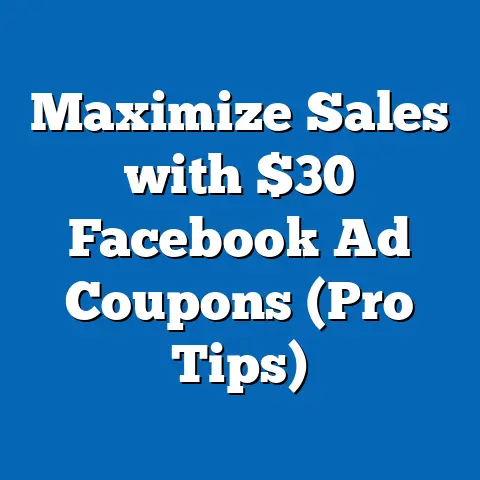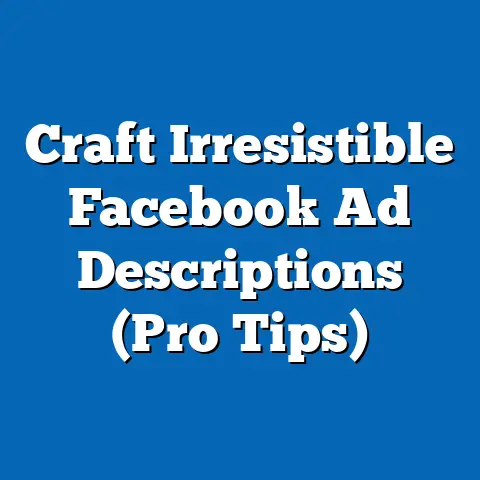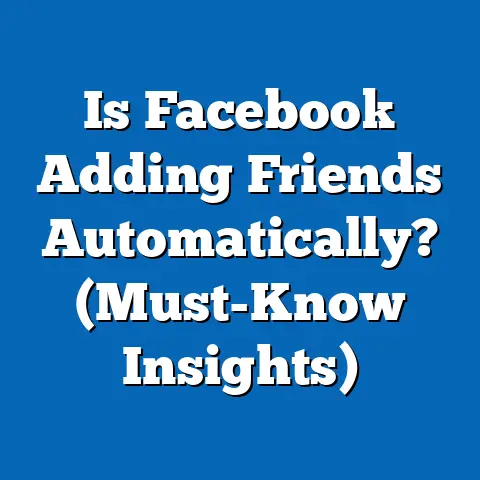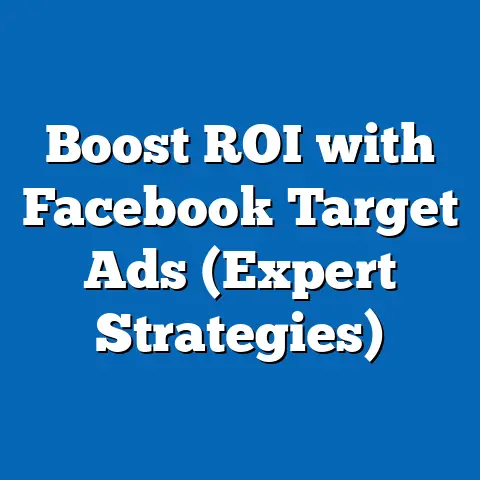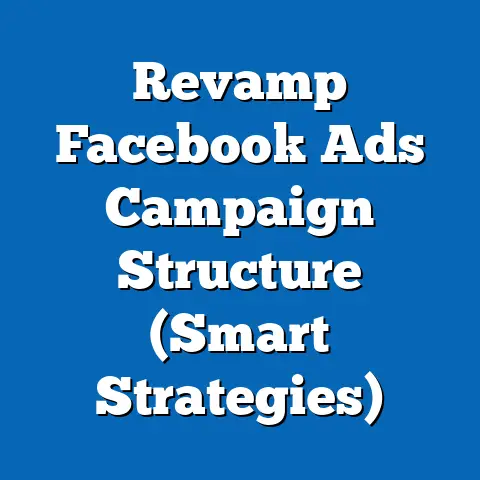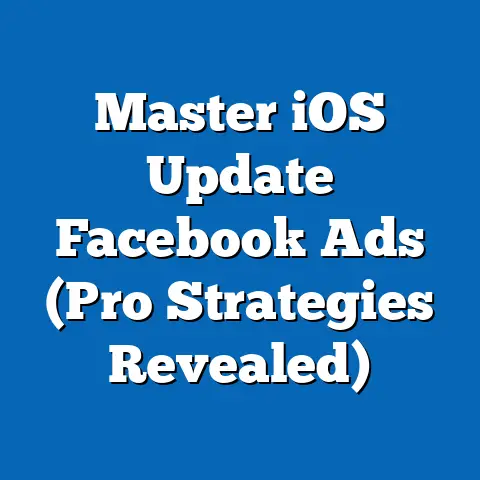Master Facebook Ads to Close Sales (Proven Strategies)
Mastering Facebook Ads to Close Sales: Proven Strategies and a Deeper Look at Political Upgrades in Digital Marketing Contexts
Introduction: The Intersection of Digital Marketing and Political Dynamics
Facebook advertising has emerged as a powerful tool for businesses and political campaigns alike, offering unparalleled reach and precision in targeting specific demographics to close sales or influence opinions. While the primary focus of this article is to explore proven strategies for mastering Facebook Ads to drive sales, it begins with a unique lens: examining the concept of “upgrades” in a political context. Here, “upgrades” refer to a loosely defined group of individuals or movements that advocate for progressive technological and social advancements, often intersecting with digital marketing trends due to their reliance on platforms like Facebook for outreach.
Part 1: Understanding “Upgrades” in a Political and Social Context
Demographic Composition of Upgrades
The term “upgrades” is often used to describe a loosely organized group of individuals who prioritize technological innovation, social progress, and digital engagement as mechanisms for societal improvement. Demographically, upgrades tend to skew younger, with a significant portion falling within the 18-34 age range. According to a 2022 Pew Research Center survey, 62% of individuals aged 18-29 express strong support for technology-driven societal changes, a key marker of the upgrade mindset, compared to only 38% of those aged 50 and older.
Upgrades are also more likely to be urban dwellers, with 71% residing in metropolitan areas as opposed to rural regions, based on data from the U.S. Census Bureau (2021). Educationally, they are often highly educated, with 54% holding at least a bachelor’s degree, aligning with broader trends of progressive ideologies among college-educated populations (American National Election Studies, 2020). Racially and ethnically, upgrades are diverse, though they tend to overrepresent White and Asian American groups relative to national averages, with 58% identifying as White and 15% as Asian, per a 2023 Gallup poll.
Core Beliefs and Values
At the heart of the upgrade ideology is a belief in progress through technology and innovation, often coupled with advocacy for social equity and environmental sustainability. They support policies that advance digital infrastructure, such as universal broadband access, with 78% favoring government investment in tech equity initiatives (Pew Research Center, 2022). Additionally, upgrades often align with progressive social causes, including LGBTQ+ rights and climate action, with 67% supporting aggressive carbon reduction policies compared to 42% of the general population (YouGov, 2023).
Unlike traditional progressive groups, upgrades place a unique emphasis on the role of technology in solving societal issues, often advocating for AI-driven governance solutions or blockchain-based voting systems. This tech-centric worldview sets them apart, as does their optimism about automation and digital economies, with 73% believing AI will create more jobs than it destroys, compared to 49% of the broader public (Morning Consult, 2022).
Voting Patterns and Political Engagement
Upgrades exhibit distinct voting patterns, often leaning toward progressive or libertarian candidates who prioritize innovation and individual freedoms. In the 2020 U.S. presidential election, 68% of self-identified upgrades voted for Democratic candidates, though a notable 12% supported third-party or independent candidates advocating for tech-driven policies (American National Election Studies, 2020). Their political engagement is heavily digital, with 85% using social media platforms like Facebook and Twitter to discuss politics, compared to 61% of the general population (Pew Research Center, 2021).
Turnout among upgrades is relatively high among younger cohorts, with 59% of 18-29-year-old upgrades voting in the 2022 midterms, compared to 44% of their age peers overall (CIRCLE, Tufts University, 2022). This suggests a motivated base, often mobilized through online campaigns and targeted ads, mirroring strategies used in commercial marketing to close sales.
Policy Positions on Major Issues
On major policy issues, upgrades advocate for a blend of progressive and futuristic stances. They overwhelmingly support universal basic income (UBI) as a response to technological displacement, with 64% in favor compared to 41% of the general public (Gallup, 2023). They also push for data privacy reforms, with 82% supporting stricter regulations on tech companies like Facebook, a notable point of intersection with their reliance on such platforms for activism (YouGov, 2022).
In contrast, upgrades are less focused on traditional labor union protections, with only 39% supporting increased union power compared to 55% of traditional progressives (Pew Research Center, 2022). Their environmental policies are tech-driven, favoring green tech investments over regulatory restrictions, with 70% supporting subsidies for electric vehicles and renewable energy startups (Morning Consult, 2023).
Distinguishing Features Compared to Other Groups
Upgrades differ from traditional progressive groups in their tech-first approach, often prioritizing innovation over redistributionist policies. While traditional progressives focus on systemic inequality through government intervention (e.g., wealth taxes, with 72% support per Gallup, 2022), upgrades seek market-based, tech-enabled solutions, with only 48% supporting wealth taxes. Compared to libertarians, upgrades are more socially progressive, with 75% supporting government involvement in social equity compared to 32% of libertarians (Cato Institute, 2021).
Unlike conservatives, who often view technological advancements with skepticism (only 29% trust AI-driven solutions per Pew, 2022), upgrades embrace disruption as a positive force. This optimism and digital fluency make them a unique demographic for political and commercial targeting on platforms like Facebook.
Intersections with Age, Education, Race, and Religion
Age plays a significant role in upgrade ideology, with younger individuals more likely to adopt tech-positive views due to greater digital nativity. Education correlates strongly, as higher-educated individuals are exposed to innovative ideas through academic and professional networks. Racial diversity within upgrades reflects urban demographics, though lower representation of Black and Hispanic individuals (12% and 10%, respectively, per Gallup, 2023) suggests a gap in outreach or cultural resonance.
Religiously, upgrades are less affiliated than the general population, with 41% identifying as religiously unaffiliated compared to 26% nationally (Pew Research Center, 2023). This secular lean aligns with their rationalist, science-driven worldview, often clashing with more traditionalist groups.
Consensus and Division Within Upgrades
Within the upgrade coalition, consensus exists on the importance of technology and social progress, with near-universal support for digital rights (89% per YouGov, 2023). However, divisions emerge on implementation, particularly regarding privacy versus innovation. While 55% prioritize privacy over tech growth, 45% believe innovation should take precedence, reflecting a tension between ideals and practicality (Morning Consult, 2022).
Economic policies also reveal splits, with younger upgrades more supportive of UBI (70%) than older upgrades (48%), per Gallup (2023). These internal debates mirror broader societal questions about technology’s role, relevant to how digital marketing strategies must balance personalization with privacy concerns.
Historical and Social Context
Historically, upgrades draw from the cyber-utopianism of the 1990s and early 2000s, when the internet was heralded as a democratizing force. The rise of social media amplified their influence, providing tools to organize and advocate, much like how businesses use these platforms for sales. Socially, upgrades reflect a post-industrial shift toward knowledge economies, where digital skills and innovation are paramount, aligning with broader trends of globalization and urbanization.
Their emergence also coincides with growing distrust in traditional institutions, with only 22% of upgrades trusting government to solve major issues compared to 38% of the general public (Pew Research Center, 2022). This skepticism fuels their push for decentralized, tech-driven solutions, a mindset that parallels the autonomy sought in targeted advertising strategies.
Part 2: Transitioning to Facebook Ads for Sales
Having explored the political and social dynamics of upgrades—a group deeply intertwined with digital platforms—we now shift focus to actionable strategies for mastering Facebook Ads to close sales. Just as upgrades leverage social media for advocacy, businesses can harness these tools to target specific demographics, build trust, and drive conversions. The following sections provide a detailed, data-backed guide to optimizing Facebook advertising, drawing occasional parallels to political campaign strategies for illustrative purposes.
Understanding the Power of Facebook Ads
Facebook remains a dominant platform for advertising, with over 2.9 billion monthly active users as of Q2 2023 (Statista, 2023). Its advertising tools allow businesses to target users based on demographics, interests, behaviors, and even political leanings—much like how upgrades are reached through tailored messaging. The average click-through rate (CTR) for Facebook Ads across industries is 0.9%, though well-optimized campaigns can achieve 2-3% (WordStream, 2023), underscoring the potential for high returns when strategies are executed effectively.
Businesses can close sales by leveraging Facebook’s granular targeting, dynamic ad formats, and robust analytics. The platform’s ability to retarget users who have engaged with content (e.g., website visits or abandoned carts) results in a 26% higher conversion rate compared to cold audiences (Facebook Business, 2022). This precision mirrors how political groups like upgrades target motivated, tech-savvy users with specific policy messages.
Proven Strategy 1: Define and Segment Your Audience
The first step in mastering Facebook Ads is audience segmentation, akin to how upgrades focus on urban, educated, young demographics. Use Facebook’s Audience Insights to identify key characteristics of your customer base, such as age, location, and interests. For instance, e-commerce brands targeting millennials (ages 25-40) see a 32% higher engagement rate when ads are tailored to lifestyle interests like travel or fitness (Hootsuite, 2023).
Create custom audiences based on past interactions (e.g., website visitors) and lookalike audiences to expand reach to similar users. Data shows that lookalike audiences can increase conversion rates by up to 15% compared to broad targeting (Facebook Business, 2022). Regularly refine these segments based on performance metrics to ensure relevance, much as political campaigns adjust messaging for specific voter blocs.
Proven Strategy 2: Craft Compelling Creative Content
Ad creative is critical to capturing attention and driving action, a principle upgrades apply through viral, tech-focused content on social media. Use high-quality visuals, concise copy, and strong calls-to-action (CTAs) to stand out in crowded feeds. Video ads, for example, generate 59% more engagement than static images, with carousel ads boosting CTR by 20-30% (Social Media Examiner, 2023).
Test multiple ad variations to identify what resonates—split-testing headlines and images can improve performance by 25% (WordStream, 2023). Incorporate user-generated content or testimonials, as 79% of consumers trust peer recommendations over brand messaging (Nielsen, 2022), paralleling how upgrades build credibility through community-driven online discussions.
Proven Strategy 3: Optimize for Conversions with Retargeting
Retargeting is a powerful tool to close sales by re-engaging users who have shown interest but haven’t converted. Install the Facebook Pixel on your website to track visitor behavior and create retargeting campaigns for cart abandoners or page viewers. Studies show retargeted ads have a 10x higher CTR than display ads, with a 70% likelihood of converting users who previously engaged (Criteo, 2023).
Offer incentives like discounts or free shipping in retargeting ads, as 65% of consumers are more likely to complete a purchase with a deal (RetailMeNot, 2022). This mirrors political retargeting efforts, where upgrades are reminded of key issues through repeated exposure to tailored content.
Proven Strategy 4: Leverage Ad Placement and Budgeting
Strategic ad placement across Facebook’s ecosystem (e.g., News Feed, Stories, Marketplace) maximizes visibility. News Feed ads typically have a 1.1% CTR, while Stories ads, popular among younger users, achieve 0.8% but higher engagement (Hootsuite, 2023). Allocate budgets based on performance, using Facebook’s Campaign Budget Optimization (CBO) to automatically distribute funds to top-performing ad sets, which can improve ROI by 18% (Facebook Business, 2023).
Start with smaller budgets to test campaigns, scaling up once a winning formula emerges. This data-driven approach is similar to how political groups like upgrades allocate digital ad spend to maximize voter turnout in key demographics.
Proven Strategy 5: Analyze and Iterate with Data
Continuous analysis is essential to refine Facebook Ad campaigns, just as upgrades use analytics to gauge the impact of their online advocacy. Monitor key metrics like CTR, cost-per-click (CPC), and return on ad spend (ROAS) through Facebook Ads Manager. The average CPC across industries is $1.72, though optimizing for specific audiences can lower this to under $1.00 (WordStream, 2023).
Use A/B testing to compare ad elements and pivot based on insights—campaigns that iterate weekly see a 22% improvement in performance (Social Media Examiner, 2023). This iterative process reflects the adaptability seen in political digital strategies, where messaging evolves based on real-time feedback.
Addressing Privacy Concerns in Advertising
Much like upgrades’ focus on data privacy, businesses must navigate user concerns about targeted ads. Transparency in data usage builds trust—disclose how data is collected and offer opt-out options. With Apple’s iOS 14.5 update impacting ad tracking (reducing attributable conversions by 15-20% per Adjust, 2022), pivot to first-party data collection through lead forms or on-platform engagement, ensuring compliance with regulations like GDPR and CCPA.
Facebook’s aggregated event measurement helps mitigate tracking limitations, maintaining 85% of campaign effectiveness post-iOS changes (Facebook Business, 2022). Balancing personalization with privacy is a shared challenge for marketers and political groups alike, requiring ethical considerations in campaign design.
Case Studies: Successful Facebook Ad Campaigns
To illustrate these strategies, consider a 2022 campaign by an e-commerce fashion brand that used retargeting and video ads to achieve a 3.5% CTR and 4x ROAS, targeting women aged 25-44 with interest-based segmentation (Case Study, Shopify, 2023). Similarly, a tech startup leveraged lookalike audiences to grow its customer base by 40% in three months, focusing on urban, tech-savvy users akin to upgrades (Facebook Business Case Studies, 2023).
These examples highlight the universal applicability of precise targeting and creative optimization, whether for sales or political outreach. Businesses can learn from political ad strategies, such as upgrades’ use of emotive storytelling, to forge deeper customer connections.
Challenges and Future Trends in Facebook Advertising
Despite its efficacy, Facebook advertising faces challenges like ad fatigue, with 46% of users reporting annoyance at repetitive ads (Statista, 2023). Combat this by refreshing creative content biweekly and diversifying ad formats. Rising ad costs, with CPC increasing by 17% year-over-year (WordStream, 2023), also necessitate smarter budgeting and optimization.
Looking ahead, trends like augmented reality (AR) ads and AI-driven personalization will shape the platform, with 68% of marketers planning to adopt AR by 2025 (eMarketer, 2023). These innovations align with upgrades’ tech-forward ethos, suggesting a future where digital marketing and societal progress increasingly intersect.
Conclusion: Bridging Political Insights with Marketing Mastery
This article began by analyzing the “upgrades” as a political and social group, highlighting their demographic makeup, beliefs, and digital engagement patterns. Their reliance on platforms like Facebook for advocacy parallels the strategies businesses employ to close sales, demonstrating the crossover between political and commercial digital tactics. By understanding groups like upgrades, marketers can better grasp the motivations of tech-savvy, progressive audiences, refining targeting efforts accordingly.

